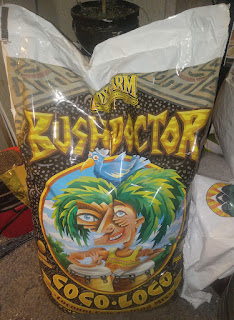When your plant gets about five to seven nodes tall you can prune it in order to change the hormones in the plant where it will change its growth pattern from straight up to more of the side branches going outward. Most growers do some sort of pruning as this usually increases the yield of the plant and the plant bushes out more. When growing indoors, you want to utilize the most room in your space horizontally and pruning is an excellent way to do that. I will cover some of those methods here today.
TOPPING METHOD
Above is an example of a topped clone. Basically, you pinch off the top of the main stem and the two nodes start to replace the one main node. This usually stunts the plant some but if the plant is healthy enough it will recover pretty fast. It's better to make sure that your plant is healthy and growing at a good rate before topping. The plant diverts its hormones now to lower nodes and you will begin to see lower growth the plant will still get taller, and you will see more of a bushy plant. This is good when you're trying to fill in the extra horizontal space in your grow area
Low-Stress Training
AN EXAMPLE OF LOW-STRESS TRAINING
With low-stress training instead of cutting or pinching the main stem your bringing the top of the main stem below the rest of the nodes by bending it downward. By doing this you change the plant's hormones to divert to make the other nodes start to grow out. In the photo above you can see that some duct tape was used to pull the main stem tip downward and hold it there. The tape is on a fan leaf but it is enough to cause the lower nodes to stretch and grow towards the light. Some prefer this method because it saves time and doesn't stress the plant as much. I personally do more topping than low-stress training. I don't mind the slowdown in growth that happens for a few days to a week. It allows time for other plants in my grow to catch up in growth or the delay helps for other purposes such as a room in the flowering room.
SUPER CROPPING TECHNIQUE
AN EXAMPLE OF A SUPER-CROPPED PLANT
Supercropping is useful to increase yields but is a little more risky and it causes more stress on your plant. Above you take a branch and gently snap the branch far enough to bend it 90 degrees so it looks like a right angle. When the plant heals, it will be harder right at the bend site and will make the branch stronger and able to hold more weight. Also, the bend will allow lower nodes to get more light. This is one of my favorite techniques to use. Some strains do not respond well to super cropping and the only way to know is to try it. It takes a level of faith to break a branch and believe it will heal. Sometimes a branch won't recover and heal up well. If this happens then I wouldn't recommend proceeding with other branches. On occasion, I will accidentally bend a branch too far and will lose a branch but I find 95 percent of the time I'm successful. So if you're not comfortable trying this then it's fully understandable.
These were just a few of the pruning techniques but I would say the main ones I have heard of. I often use a mix of topping and super cropping. You will learn with experience and practice. Happy Pruning!






